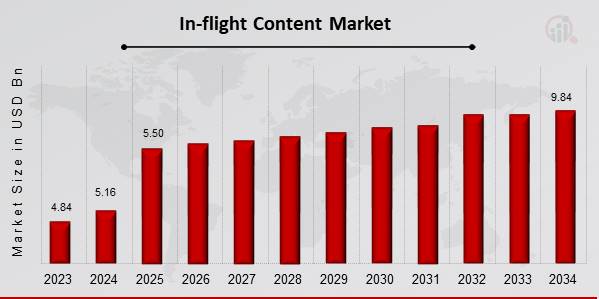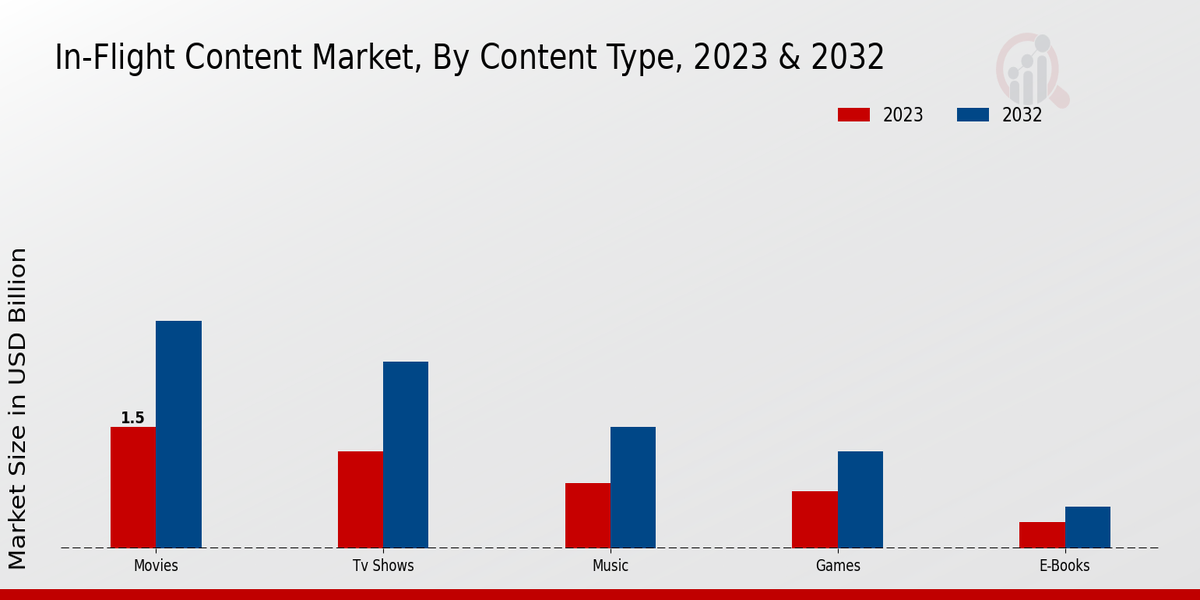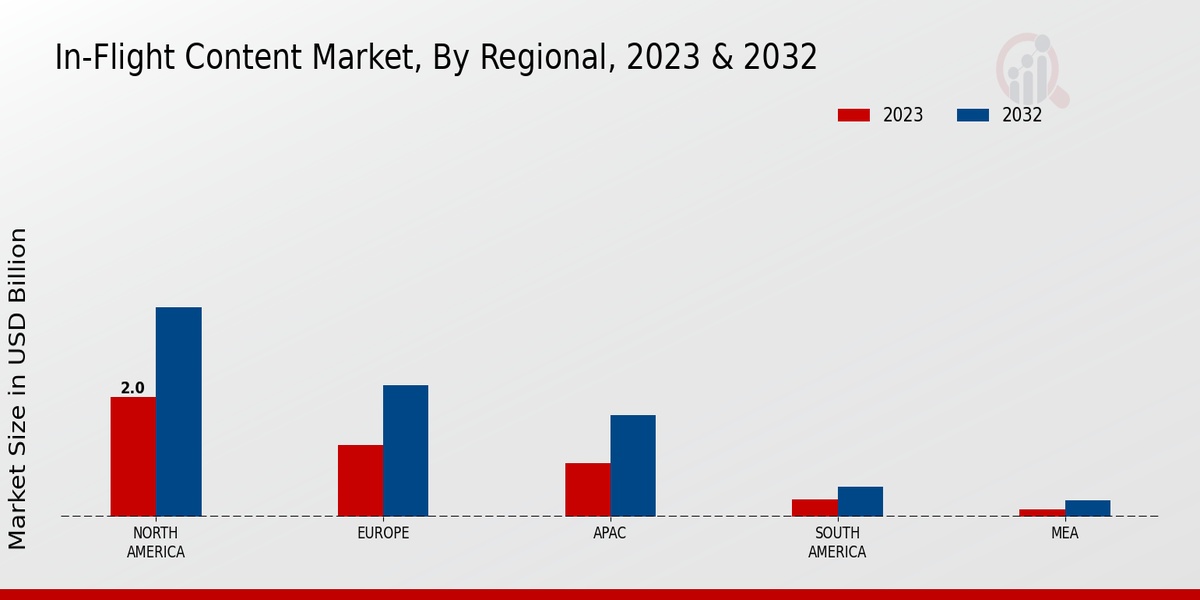In-flight Content Market Overview
In-flight Content Market Size was estimated at 5.16 (USD billion) in 2024. The In-flight Content Market is expected to grow from 5.5 (USD billion) in 2025 to 9.84 (USD billion) by 2034. The In-flight Content Market CAGR (growth rate) is expected to be around 6.70% during the forecast period (2025 - 2034).

Source Primary Research, Secondary Research, MRFR Database and Analyst Review
Key In-flight Content Market Trends Highlighted
The In-flight Content Market is driven by the increasing demand for enhanced passenger experiences and the growth of the airline industry. Airlines recognize the significance of entertainment and connectivity during flights as a means to improve customer satisfaction and loyalty.
This demand is further fueled by the rise of personal devices, where travelers expect seamless access to digital content. As technology evolves, airlines are compelled to adopt advanced in-flight systems that offer a diverse range of entertainment options, from movies and music to interactive games and real-time information.
Opportunities abound in the In-flight Content Market for providers to innovate and expand their service offerings.
Collaborations between airlines and streaming platforms can create tailored entertainment experiences that appeal to a wide audience. Additionally, the growing trend of offering personalized content based on passenger preferences is an avenue worth exploring.
As more travelers opt for premium services, there is potential for airlines to differentiate themselves through exclusive partnerships and content arrangements. Furthermore, the integration of in-flight Wi-Fi enables passengers to access their favorite content from their personal devices, thereby enhancing the overall travel experience.
Recent trends indicate a shift toward sustainability and environmentally conscious practices within the aviation sector, which also influences in-flight content strategies.
Airlines are increasingly looking to provide eco-friendly options, including digital media that reduces the need for physical materials such as magazines and DVDs.
Moreover, there is a noticeable increase in the demand for region-specific content, reflecting the diverse backgrounds of travelers. As airlines adapt to these various trends, the In-flight Content Market is expected to continue evolving, focusing on delivering quality, convenience, and sustainability.
In-flight Content Market Drivers
Increasing Demand for Passenger Entertainment Options
The In-flight Content Market is experiencing substantial growth driven by increasing demand for passenger entertainment options during flights. With the significant expansion of the aviation sector, airlines are continually seeking ways to enhance the travel experience for their customers.
One of the primary means of doing so has been the introduction of a wider range of in-flight content, catering to the diverse preferences of passengers across various demographics.
Passengers are increasingly spending hours of travel time on board, leading them to seek engaging and enjoyable content. This has resulted in a push for more advanced and user-friendly in-flight entertainment systems that offer not only movies and TV shows but also music, games, and interactive content.
The evolving nature of consumer preferences, particularly favoring on-demand content, has prompted airlines to invest in upgrading their in-flight content offerings.
Furthermore, the rise of personal devices such as smartphones, tablets, and laptops has influenced the way passengers consume content while traveling. Airlines are adapting to this trend by enabling connectivity options onboard, allowing passengers to stream their favorite media directly from their devices or access a broader library of in-flight entertainment.
These developments signify a strong growth trajectory for the In-flight Content Market, creating opportunities for content providers, technology developers, and airline operators alike.
This growing emphasis on passenger-centric content is expected to lead to significant advancements in the quality and variety of entertainment provided, ultimately enhancing brand loyalty and customer satisfaction.
Technological Advancements in In-Flight Entertainment Systems
Technological advancements play a pivotal role in shaping the In-flight Content Market. The continuous evolution of in-flight entertainment systems, including the integration of high-speed Wi-Fi, innovative touch-screen interfaces, and mobile device compatibility, has revolutionized how passengers interact with in-flight content.
Airlines are embracing these advancements to offer a more immersive and personalized entertainment experience that aligns with the modern consumer's expectations.
Moreover, improvements in data streaming capabilities have allowed airlines to expand content libraries significantly, providing passengers with an extensive selection of movies, shows, and interactive gaming options.
As technology continues to progress, airlines that adopt cutting-edge entertainment solutions are better positioned to attract and retain customers.
Growing Focus on Passenger Experience and Comfort
An increasing focus on enhancing passenger experience and comfort is driving the growth of the In-flight Content Market. Airlines recognize that providing an engaging and comfortable environment during flights is essential for customer satisfaction.
This has led to investments in enriched in-flight content and entertainment systems aimed at making travel more enjoyable. As airlines prioritize the passenger experience, there is a growing emphasis on services that cater to specific traveler preferences, allowing them to access culturally relevant content and personalized entertainment options.
In-flight Content Market Segment Insights
In-flight Content Market Content Type Insights
The segment is characterized by several categories including Movies, TV Shows, Music, Games, and E-books, each contributing uniquely to the market.
Movies dominated this segment, holding a significant market value of 1.5 USD billion currently, and expected to grow to 2.8 USD billion by 2032. This popularity can be attributed to the engaging experience they offer passengers, making them a vital part of in-flight entertainment.
TV Shows also held a notable position, valued at 1.2 USD billion in 2023 and projected to rise to 2.3 USD billion in the coming years. This growth reflects the increasing demand for binge-worthy content that resonates with a variety of viewer preferences during air travel.
Music, while smaller in comparison, showed commendable growth with a valuation of 0.8 USD billion now and an expected increase to 1.5 USD billion, driven by the desire for personalized playlists and curated audio experiences.
Games, valued at 0.7 USD billion in 2023 and anticipated to grow to 1.2 USD billion, represented a rising trend in passenger engagement, particularly among younger travelers seeking an interactive distraction while flying.
Lastly, E-books, with a valuation of 0.33 USD billion, are projected to reach 0.52 USD billion, appealing to passengers who prefer to immerse themselves in reading during flights. Collectively, the In-flight Content Market data indicates a shift towards diverse content offerings to enhance passenger satisfaction and engagement during travel.
This evolving landscape showcases distinct growth trajectories among different content types, influenced by changing consumer preferences, technological advancements, and the increasing focus on improving the overall in-flight experience.
As such, the In-flight Content Market is on a promising path, with each content type playing a crucial role in contributing to market growth over the upcoming years.
The growth drivers in this market include advancements in in-flight streaming technology, a growing demand for high-quality entertainment, and the importance of differentiating airline offerings through established partnerships with content providers.
However, challenges such as licensing restrictions, the need for robust Wi-Fi connectivity, and competition from alternative entertainment options must also be navigated to fully realize the market's potential.
The In-flight Content Market statistics reflect an exciting evolution in how airlines conceptualize and deliver entertainment, pushing the bounds of traditional in-flight experiences.
Source Primary Research, Secondary Research, MRFR Database and Analyst Review
In-flight Content Market Delivery Method Insights
The Delivery Method segment encompasses various approaches, including streamed content, pre-loaded content, real-time content, and on-demand content. Streamed content is increasingly popular as it allows for a vast library of options that can be accessed instantly, appealing to tech-savvy travelers.
Pre-loaded content has gained traction due to its reliability in providing entertainment without requiring internet connectivity, ensuring passengers can enjoy a seamless experience.
Real-time content, while less widespread, is notable for enhancing connectivity and providing live updates, especially for business travelers. On-demand content dominates the market, enabling passengers to choose what they want to watch at their convenience, catering to personalized experiences.
As the demand for diverse entertainment options grows, the In-flight Content Market segmentation reflects shifting passenger preferences and highlights opportunities for airlines to enhance customer satisfaction through innovative content delivery solutions.
Moreover, evolving technology and increasing investments in in-flight entertainment systems are expected to propel significant growth in this segment, creating a competitive landscape within the In-flight Content Market.
In-flight Content Market Aircraft Type Insights
The market growth is influenced by several factors, including technological advancements, the changing preferences of passengers for in-flight entertainment, and the necessity to enhance overall travel experiences.
The Commercial Aircraft segment holds a significant share of the market, driven by the increasing number of air travel passengers and airlines seeking to differentiate themselves through quality content offerings.
Similarly, the Private Jet segment is also notable, as it caters to the luxury market, where high-net-worth individuals expect a premium in-flight experience. Furthermore, while the Cargo Aircraft segment is less focused on entertainment, the rise in e-commerce and demand for efficient logistics has contributed to a growing interest in in-flight content solutions for improved operational efficiency.
The In-flight Content Market statistics indicate that the diversity in aircraft types leads to varied content requirements, making customization in offerings vital for service providers across these categories.
Overall, the interplay of market growth, technological trends, and shifting consumer demands continues to shape the landscape of this segment.
In-flight Content Market End User Insights
Airlines play a pivotal role as they seek to differentiate their services by offering appealing content to passengers, which directly influences customer satisfaction and airline loyalty. Conversely, travel agencies utilize in-flight content to better market travel packages, thereby tapping into this industry for enhanced promotional efforts.
Additionally, corporate clients are increasingly recognizing the importance of providing quality in-flight entertainment for business travelers, as it enhances productivity and overall travel experience. This diverse end-user landscape showcases the multifaceted nature of the In-flight Content Market segmentation, with each player contributing to the market’s adaptability and growth potential.
The growing focus on technological advancements and high customer expectations are key growth drivers that present opportunities, although challenges such as rapid technological changes and maintaining content relevance remain pertinent in this evolving landscape.
In-flight Content Market Regional Insights
The Regional segmentation of the In-flight Content Market showcases a variety of market valuations, with North America leading in dominance. In 2023, North America was valued at 2.0 USD billion, significantly contributing to the overall market dynamics and is expected to rise to 3.5 USD billion by 2032.
Europe followed closely, with a valuation of 1.2 USD billion in 2023, indicating its prominent role within the industry, anticipated to grow to 2.2 USD billion by 2032. The APAC region, valued at 0.9 USD billion in 2023, was also on the rise, looking to reach 1.7 USD billion by 2032, illustrating the increasing demand for innovative in-flight entertainment solutions.
South America and MEA held smaller market shares, with South America valued at 0.3 USD billion and MEA at 0.13 USD billion in 2023, which reflects their developing potential and gradual growth opportunities in the In-flight Content Market.
The disparities in regional valuations underscore the strategic focus required for companies to tailor their offerings to specific markets, highlighting the importance of understanding local consumer preferences as they navigate their growth strategies.
Source Primary Research, Secondary Research, MRFR Database and Analyst Review
In-flight Content Market Key Players and Competitive Insights
The In-flight Content Market is a dynamic landscape characterized by rapid technological advancements and shifting consumer preferences, which impact how airlines deliver entertainment and information to passengers.
As the aviation industry increasingly recognizes the significance of enhancing the passenger experience, providers of in-flight content have emerged as vital contributors to these strategies.
Competition within the market is influenced by several factors, including advancements in connectivity technologies, content diversity, regulatory frameworks, and evolving consumer expectations regarding digital and interactive media during air travel.
Players in this sector must maintain a keen understanding of market trends and consumer behavior while being innovative in their offerings and strategic in their partnerships to capture and retain market share.
Gogo has managed to establish a strong presence within the In-flight Content Market, primarily recognized for its advanced connectivity solutions and content delivery systems. The company's strength lies in its ability to deliver high-speed internet access alongside a broad array of entertainment options, catering to the diverse needs of both leisure and business travelers.
Gogo’s commitment to enhancing the passenger experience through seamless connectivity and engaging content has led to successful partnerships with numerous airlines. Its innovative technology platform and extensive research on user preferences position Gogo favorably against competitors, enabling the company to provide comprehensive solutions that keep pace with changing dynamics in the in-flight content domain.
Telesat plays a significant role in the In-flight Content Market by leveraging its expertise in satellite communications to deliver robust connectivity solutions for airlines. The company is recognized for its reliable and expansive satellite network, which provides high-quality bandwidth necessary for enriching in-flight entertainment options and seamless connectivity.
Telesat's focus on developing next-generation satellite technology ensures that airlines can offer passengers not only traditional media content but also contemporary streaming options and applications.
This technological edge underscores Telesat's capacity to respond to the growing demand for high-speed internet solutions in aviation, enabling it to be a competitive player in shaping the in-flight experience amidst a rapidly evolving industry landscape.
Key Companies in the In-flight Content Market Include
- Gogo
- Telesat
- Inmarsat
- Lufthansa Systems
- Honeywell International
- Panasonic Avionics
- Sitaonair
- Marketron
- Viasat
- Skycast Solutions
- Eagle Entertainment
- AeroMobile
- Kontron
- Thales Group
- AirFi
In-flight Content Market Developments
Recent developments in the In-flight Content Market reveal a significant emphasis on enhancing passenger experiences and connectivity solutions. Companies like Panasonic Avionics and Viasat are particularly noteworthy, as they continue to innovate in providing high-speed internet and diverse entertainment options aboard aircraft.
The market has also witnessed a surge in collaborations, with Gogo and Inmarsat forming strategic partnerships to improve their service offerings. Additionally, Honeywell International has been expanding its in-flight connectivity solutions, targeting both commercial airlines and business jets.
Mergers and acquisitions are actively shaping the landscape; Eagle Entertainment has successfully merged with a prominent technology firm to enhance its content delivery systems, while Thales Group's acquisition of a smaller tech company is expected to bolster its in-flight entertainment capabilities significantly.
Market valuations indicate a robust growth trajectory, driven by increasing demand for in-flight connectivity and personalized content, resulting in competitive dynamics among key players such as Lufthansa Systems, AeroMobile, and Skycast Solutions. The influx of investments in this sector further underscores the industry's potential for expansion and innovation, positioning it for substantial growth in the coming years.
In-flight Content Market Segmentation Insights
In-flight Content Market Content Type Outlook
- Movies
- TV Shows
- Music
- Games
- E-books
In-flight Content Market Delivery Method Outlook
- Streamed Content
- Pre-loaded Content
- Real-time Content
- On-Demand Content
In-flight Content Market Aircraft Type Outlook
- Commercial Aircraft
- Private Jet
- Cargo Aircraft
In-flight Content Market End User Outlook
- Airlines
- Travel Agencies
- Corporate Clients
In-flight Content Market Regional Outlook
- North America
- Europe
- South America
- Asia Pacific
- Middle East and Africa
In-flight Content Market Report Scope
| Report Attribute/Metric |
Details |
| Market Size 2024 |
5.16(USD billion) |
| Market Size 2024 |
5.5(USD billion) |
| Market Size 2034 |
9.84(USD billion) |
| Compound Annual Growth Rate (CAGR) |
6.70% (2025 - 2034) |
| Report Coverage |
Revenue Forecast, Competitive Landscape, Growth Factors, and Trends |
| Base Year |
2024 |
| Market Forecast Period |
2025 - 2034 |
| Historical Data |
2021 - 2024 |
| Market Forecast Units |
USD billion |
| Key Companies Profiled |
Gogo, Telesat, Inmarsat, Lufthansa Systems, Honeywell International, Panasonic Avionics, Sitaonair, Marketron, Viasat, Skycast Solutions, Eagle Entertainment, AeroMobile, Kontron, Thales Group, AirFi |
| Segments Covered |
Content Type, Delivery Method, Aircraft Type, End User, Regional |
| Key Market Opportunities |
Personalized content experiences, Expansion of streaming partnerships, Augmented reality in entertainment, Enhanced passenger engagement tools, and Growth in premium in-flight services |
| Key Market Dynamics |
growing demand for personalized content, advancements in streaming technology, increasing competition among airlines, emphasis on passenger experience, regulatory compliance, and content licensing |
| Countries Covered |
North America, Europe, APAC, South America, MEA |
Frequently Asked Questions (FAQ) :
The In-flight Content Market is expected to be valued at 9.84 USD billion by 2034.
The expected CAGR for the In-flight Content Market from 2025 to 2034 is 6.70%.
North America is expected to dominate the In-flight Content Market with a valuation of 3.5 USD billion by 2034.
The market size of Movies in the In-flight Content Market is projected to reach 2.8 USD billion by 2034.
Key players in the In-flight Content Market include Gogo, Inmarsat, Panasonic Avionics, and Viasat.
The market size for TV Shows is expected to grow to 2.3 USD billion by 2034.
The expected market size for Music in the In-flight Content Market is 1.5 USD billion by 2034.
The projected value of the In-flight Content Market in the APAC region is 1.7 USD billion by 2034.
Challenges such as technological advancements and changing consumer preferences may impact the In-flight Content Market.
The anticipated market value for E-books is projected to reach 0.52 USD billion by 2034.

















